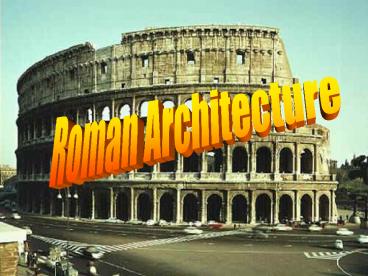Roman Architecture - PowerPoint PPT Presentation
Title:
Roman Architecture
Description:
... room topped by a dome and was fronted by a porch of Corinthian columns. The dome on top is 142 feet in diameter The oculus, ... – PowerPoint PPT presentation
Number of Views:174
Avg rating:3.0/5.0
Title: Roman Architecture
1
Roman Architecture
2
Historical Background
- The buildings found in Rome at the peak of its
power, were large and impressive - These included theaters, baths, temples,
libraries, imperial palaces and basilicas (public
meeting places). - Public monuments celebrating the achievements of
emperors existed as arches and columns.
3
- The Romans borrowed architectural features from
the Etruscans and the Greeks. - Form of the Arch- Etruscans
- Corinthian Architectural order- Greeks
- The Romans mastered the design of the arch and
introduced a new type of building material,
concrete, to form their own architectural style.
4
Corinthian
Doric
Ionic
5
Roman Concrete
- The Romans invented a new building material that
we still use today, concrete. - They mixed stone, sand, lime mortar and water. It
dried and hardened into concrete. - The surviving Roman monuments testify to the
strength and durability of concrete.
6
Arches
- The Romans made great use of the Etruscan Arch
- The Romans used the arch in various ways. They
used it to create architectural structures of
great size and strength. - The vault was created by putting a series of
arches side by side.
7
(No Transcript)
8
- The dome was created by several arches crossing
in different directions in a circular space. - Arches and Concrete revolutionized Roman
architecture. - The Arch can be seen in the construction of city
gates, bridges and aqueducts. As well as theaters
and ampitheaters (round theaters).
9
Colosseum
- It was the most famous example of an ampitheater
in Rome. - Emperor Vespasian started construction in 72 A.D
and completed it in 80 A.D.
10
- Could hold about 55,000 spectators.
- The Colosseum was used to entertain the public
with games. These games were a way for an emperor
to increase his popularity. - The games started with comical acts and ended
with - fights to the death between
- animals and gladiators or between gladiators
and gladiators.
11
Aqueducts
- It is a water transport system that allows water
to flow through pipes or channels to carry water
from a well or stream into the town. - The water was distributed throughout a complex
system of lead or earthenware pipes.
12
- It moved the water using gravity
- The aqueduct had to be built at exactly the right
angle in order to use gravity to its full
potential. - It was important for the route of water to be
constant and running. - They were used to bring water to areas that did
not have natural water resources.
13
The Pont de Gard
- Was a masterpiece built and named for the Gard
River. - It channeled water from Nimes, France.
- Highest of all Roman aqueducts.
- It consisted of three tiers of arches
- The Pont de Gard is a testimony to the
engineering and construction skill of the Romans.
14
Pantheon
- The Pantheon dates back to 27 B.C., when it was
first built by Marcus Agrippa. - Emperor Hadrian rebuilt it between 117-125 A.D.
after it burned to the ground in 80 A.D. - Was a temple dedicated to All Gods.
- The original use of the Pantheon is unknown, but
it is assumed it was used as a temple.
Temple of All Gods
15
- It was made of solid concrete consisted of a
round main room topped by a dome and was fronted
by a porch of Corinthian columns. - The dome on top is 142 feet in diameter
- The oculus, the hole in the top of the dome is
used as a light source for the interior
16
Activity
- Become a Roman Architect
- Using the features we discussed such as arches,
columns or domes draw your own Roman structure - Use the structures discussed as a guideline for
your own Roman Structure - Provide a name
- Be creative and use color
- On the Back Write
- Name of the Structure.
- Who you designed it for.
- What Features you used.































